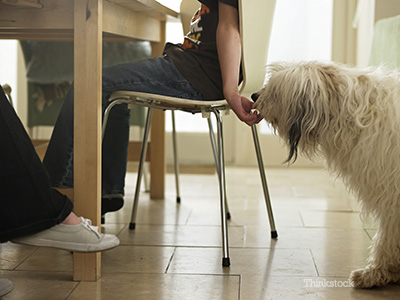
What is Campylobacter?
Among people, “Campylobacter [jejuni] is one of the most common causes of food poisoning in the United States,” according to foodsaftey.gov. An estimated 2 million cases occur each year in this country.
It’s is a genus of microaerophilic (requiring oxygen but only at low levels), gram-negative bacteria that causes intestinal infections and subsequent diarrhea. The World Health Organization (WHO) says Campylobacter inhabits the intestinal tract of warm-blooded animals such as poultry and cattle; it’s frequently found in foods derived from those animals.
Campylobacter is normally spread by way of contaminated, uncooked meats. Infection from Campylobacter can be easy for people to avoid since the organism is killed by cooking. Infection among dogs and cats may be more difficult to control as they are happy to eat raw meat and could also get it through direct contact with contaminated stool. As with most food-borne organisms, to help prevent Campylobacter infections, make sure to follow basic food hygiene practices when preparing food.
What are the symptoms of Campylobacter infection in dogs and cats?
in dogs and cats?
The University of Wisconsin’s School of Veterinary Medicine says that, “Infection is most common in puppies and kittens under 6 months of age, but Campylobacter spp. can also be isolated from clinically normal adult dogs and cats (up to 30%).” The most noticeable symptom is diarrhea, which is thought to be due to the action of a cholera-like enterotoxin and a cytotoxin.
Other — uncommon — symptoms include:
- Vomiting
- Anorexia
- Fever
Diagnosing Campylobacter infection in dogs and cats
The most reliable way to test for Campylobacter is to culture your pet’s stool when he has diarrhea. Growing Campylobacter requires special media and a decreased oxygen environment which can be done at a veterinary diagnostic laboratory. More recently, polymerase chain reaction (PCR) testing is available to detect DNA from Campylobacter in feces from an animal with diarrhea. Since there are many infectious causes of diarrhea it is recommended to perform a fecal enteric pathogen culture and/or diarrhea PCR panel.
How common is Campylobacter?
Gretchen Goetz (of Food Safety News) reports that, “In recent years, studies have found that between 50 to 80 percent of chickens sold at retail are contaminated with Campylobacter.”
How can I prevent Campylobacter?
To protect your pet and yourself from campylobacter infection I recommend that you:
- Feed only commercially prepared or cooked foods to your pet.
- Always cook meat, especially poultry, to safe minimum temperatures.
- Keep raw meat, especially poultry, separate from other foods
- Do not drink raw or unpasteurized milk.
How is Campylobacter treated?
First of all, finding Campylobacter from an animal with diarrhea does not necessarily implicate Campylobacter as a cause of the diarrhea. Therefore, other causes of diarrhea should still be considered and treated. In addition, because the majority of cases of dogs and cats with diarrhea (believed to be caused by Campylobacter) are uncomplicated and resolve themselves. The diarrhea usually goes away with with supportive therapy alone. Your veterinarian may only prescribe antibiotic therapy if your pet is immunocompromised, has a fever or if your pet’s diarrhea is bloody.
If you have any questions or concerns, you should always visit or call your veterinarian -- they are your best resource to ensure the health and well-being of your pets.
